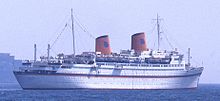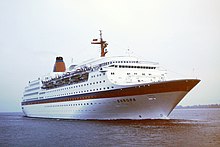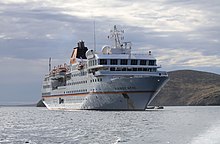Hapag-Lloyd cruises: Difference between revisions
Seavoyage1 (talk | contribs) Independent page focusing on just Hapag-Lloyd Cruises, separate from the cargo line. Tags: nowiki added possible cut and paste move or recreation Visual edit |
(No difference)
|
Revision as of 04:19, 28 June 2023
History[edit]
The company was formed on September 1, 1970, by the merger of two German transportation/maritime companies, Hamburg-American Line (HAPAG), which dated from 1847, and Norddeutscher Lloyd (known in English as North German Lloyd), which was formed in 1857.
HAPAG
Main article: Hamburg America Line The Hamburg-Amerikanische Packetfahrt-Aktien-Gesellschaftfor shipping across the Atlantic Ocean was founded in Hamburg. In 1912, Hapag built the first of their "Big Three" ocean liners; the Imperator, followed by its twin Vaterland. A third twin, Bismarck, was under construction at the outbreak of World War I and was completed after the war for White Star Line as the Majestic. These were the first liners to exceed 50,000 gross tons[clarification needed] and 900 feet (274 m) in length. During World War I, the majority of Hapag's fleet of 175 ships were wiped out, and most of the surviving ships (including the "Big Three") had to be turned over to the winning side as war reparations. After the war's end, Hapag rebuilt its fleet with much smaller ships than before the war, but their fleet was again mostly wiped out during World War II, and the surviving ships turned over to Allied powers.
Norddeutscher Lloyd
Main article: Norddeutscher Lloyd Norddeutscher Lloyd (NDL) was formed in 1857 in the City-State of Bremen, offering passenger and cargo transportation between Bremen and New York, with an emphasis on emigration to the United States. Service started in June 1858 with the Bremen, the first of four steamships, and the company established its American base at Hoboken, New Jersey. NDL eventually built a large fleet of ships that carried many thousands of emigrants westwards, with around 218,000 passengers transported across the Atlantic in 1913 alone.
The outbreak of World War I resulted in the internment of 32 vessels in US ports, a status later changed to confiscation when the US entered the war in 1917. Likewise, its Hoboken base was confiscated, and turned over to the US Navy, which used it as a transshipping point for the duration. As with HAPAG, those NDL ships surviving the war were eventually confiscated as reparation, leaving the company to start over from scratch.
US-Operations were resumed in 1922, when NDL was able to purchase its former base from the United States Alien Property Administrator.[citation needed] NDL launched a new Bremen and Europa in 1929–30.
During World War II, NDL repeated its World War I experience, with some parts of its fleet again being interned at the outbreak of the war, while a number of vessels remained under NDL control. One such exception was the Bremen, which raced across the Atlantic, and achieved protection at Murmansk in 1939, before eventually making a dash for Bremerhaven, where she was ultimately destroyed by a fire in 1941.
Passenger service resumed in 1954 with the Gripsholm formerly belonging to the Swedish American Line (the ship was renamed to MS Berlin only the following year). Later two other second-hand ships, SS Bremen(formerly Pasteur) and MS Europa (formerly Swedish American Line's Kungsholm), were purchased.
NDL attained several speed records over the years. Notable among them was the record for the run between Southampton and New York of eight days in 1881, which was set by the Elbe; and the record for the fastest transatlantic crossing set by the new Bremen in 1929.
Hapag-Lloyd Cruises
Hapag-Lloyd Kreuzfahrten was subsidiary of Hapag-Lloyd AG. In 2008, TUI AG integrated Hapag-Lloyd Kreuzfahrten. It was renamed Hapag-Lloyd Cruises in 2016. In 2020, Hapag-Lloyd Kreuzfahrten was sold to TUI Cruises, a joint venture between TUI and Royal Caribbean.[1]
Current Fleet[2]
| Name | Image | Built | In service for HAPAG-LLOYD Cruises | Tonnage | Yard Built |
|---|---|---|---|---|---|
| Europa |  |
1999 | 1999–Present | 28,890 GT | Kvaerner Masa-Yards Hietalahti shipyard, Helsinki, Finland |
| Europa 2 | 
|
2013 | 2013-present | 42,830 GT | Chantiers de l'Atlantique, France |
| Hanseatic Inspiration | 
|
2019 | 2019-present | 15,540 GT | Vard Shipyard, Romania |
| Hanseatic Nature | 
|
2019 | 2019-present | 15,540 GT | Vard Shipyard, Romania |
| Hanseatic Spirit | 
|
2021 | 2021-present | 15,540 GT | Vard Shipyard, Romania |
Former Fleet
| Name | Image | Built | Tonnage | In service for HAPAG-LLOYD Cruises | |
|---|---|---|---|---|---|
| Bremen |  |
1938 | 32,360 GRT | 1970-1971 | |
| Europa |  |
1952 | 21,164 GRT | 1970-1981 | |
| Finnstar |
|
1967 | 8,583 GRT | 1979-1980 | |
| Europa |  |
1981 | 37,049 GT | 1981-1999 | |
| Bremen |  |
1990 | 6,752 GT | 1993-2021 | |
| Hanseatic |  |
1993 | 8,445 GT | 1996-2018 | |
| Columbus |  |
1997 | 15,067 GT | 1997-2012 | |
| Columbus 2 | 
|
1998 | 30,277 GT | 2012–2014 |
- ^ "TUI Completes Sale of Hapag-Lloyd to Royal Caribbean Joint Venture". The Maritime Executive. Retrieved 2023-06-28.
- ^ "Our Ships - Hapag-Lloyd Cruises". www.hl-cruises.com. Retrieved 2023-06-28.

